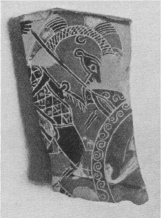Notes
The Apology of Plato
-
- Published online by Cambridge University Press:
- 23 December 2013, pp. 83-84
-
- Article
- Export citation
Research Article
The Progress of Greek Epigraphy, 1933–1934
-
- Published online by Cambridge University Press:
- 23 December 2013, pp. 172-223
-
- Article
- Export citation
Notes
An Orphic bowl
-
- Published online by Cambridge University Press:
- 23 December 2013, p. 84
-
- Article
- Export citation
An Attic Black-figure Cup-fragment
-
- Published online by Cambridge University Press:
- 23 December 2013, pp. 224-227
-
- Article
- Export citation
Notices of Books
The Geography of the Mediterranean Region: its relation to Ancient History. By Ellen Churchill Semple. Pp. x + 738; 1 plate. London: Constable & Co., 1932. 21s.
-
- Published online by Cambridge University Press:
- 23 December 2013, p. 85
-
- Article
- Export citation
Notes
More Boeotian Geometricising Vases
-
- Published online by Cambridge University Press:
- 23 December 2013, pp. 227-228
-
- Article
- Export citation
The “Aphrodite” of Lyons
-
- Published online by Cambridge University Press:
- 23 December 2013, p. 228
-
- Article
- Export citation
Notices of Books
Zur Kenntnis der Anthropologie der prähistorischen Bevölkerung der Insel Cypern. By Carl M. Fürst. (Lund Univ. Årsskrift, N.F. II, Bd. 29, No. 6.) Pp. 106; 48 plates, 52 figs. Lund: Ohlsson, 1933.
-
- Published online by Cambridge University Press:
- 23 December 2013, p. 85
-
- Article
- Export citation
Notes
Mystical Allusions in the Oresteia
-
- Published online by Cambridge University Press:
- 23 December 2013, pp. 228-230
-
- Article
- Export citation
Notices of Books
Primitive Arts and Crafts. By R. U. Sayce. Pp. xiii + 291; 58 figs, in text. Cambridge University Press, 1933. 8s. 6d.
-
- Published online by Cambridge University Press:
- 23 December 2013, pp. 85-86
-
- Article
- Export citation
Notes
The Dionysiac Painter
-
- Published online by Cambridge University Press:
- 23 December 2013, pp. 230-232
-
- Article
- Export citation
Notices of Books
Die Religion der Ägypter. By A. Erman. Pp. xvi + 465; 10 plates, 186 figs. Berlin: W. de Gruyter, 1934. 7·50 m.
-
- Published online by Cambridge University Press:
- 23 December 2013, p. 86
-
- Article
- Export citation
Orchomenos III: die Keramik der frühen Bronzezeit. By E. Kunze. Pp. 99; 34 plates, 43 illustrations. Munich: Beck, 1934.
-
- Published online by Cambridge University Press:
- 23 December 2013, pp. 86-87
-
- Article
- Export citation
Notes
New Light on the Grylli
-
- Published online by Cambridge University Press:
- 23 December 2013, pp. 232-235
-
- Article
- Export citation
Notices of Books
Die Geographie des Homerischen Epos. By R. Hennig. (Neue Wege zur Antike, I, 10.) Pp. vi + 102. Leipzig and Berlin: Teubner, 1934. 4·80 m.
-
- Published online by Cambridge University Press:
- 23 December 2013, pp. 87-88
-
- Article
- Export citation
The Palace of Minos: a comparative account of the successive stages of the early Cretan Civilisation as illustrated by the Discoveries at Knossos. By SirArthur Evans. Vol. IV, in two Parts. Pp. 1018, with 966 figures in the text, Coloured Plates XXVII–XXXV, Supplementary Plates XLIII–LXIX, and four General Plans. London: Macmillan & Co., 1935. £9 9s.
-
- Published online by Cambridge University Press:
- 23 December 2013, pp. 236-238
-
- Article
- Export citation
L'Isola di Cos nell' antichitá classica. By A. N. Modona. (Memorie pubblicate a cura dell' Istituto Storico-Archeologico di Rodi, I.) Pp. 239; 18 plates and 2 maps. Rhodes: Istituto Storico-Archeologico, 1933.
-
- Published online by Cambridge University Press:
- 23 December 2013, p. 88
-
- Article
- Export citation
The Swedish Cyprus Expedition: Finds and Results of the Excavations in Cyprus, 1927–1931. By Einar Gjerstad and others. Vol. I, pp. l + 578; Vol. II, pp. xlv + 861. Plates, Vol. I, 155; Vol. II, 250. Stockholm: The Swedish Cyprus Expedition, 1934 and 1935.
-
- Published online by Cambridge University Press:
- 23 December 2013, pp. 238-240
-
- Article
- Export citation
Die Grabhügelnekropole bei Duvanlij in Südbulgarien. By Bogdan D. Filow with the co-operation of Ivan Welkow and Vassil Mikow. Pp. vii + 242; 16 plates and 229 illustrations in the text. Sophia: Bulgarian Archaeological Institute, 1934.
-
- Published online by Cambridge University Press:
- 23 December 2013, pp. 240-242
-
- Article
- Export citation
Attische Mauern. By Walter Wrede. Pp. 67; 60 plates, 10 figures. Athens: German Archaeological Institute, 1933.
-
- Published online by Cambridge University Press:
- 23 December 2013, pp. 88-89
-
- Article
- Export citation

